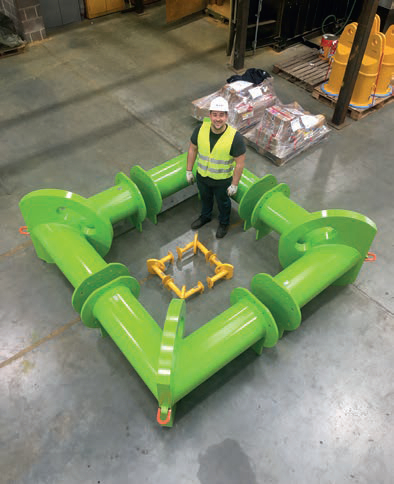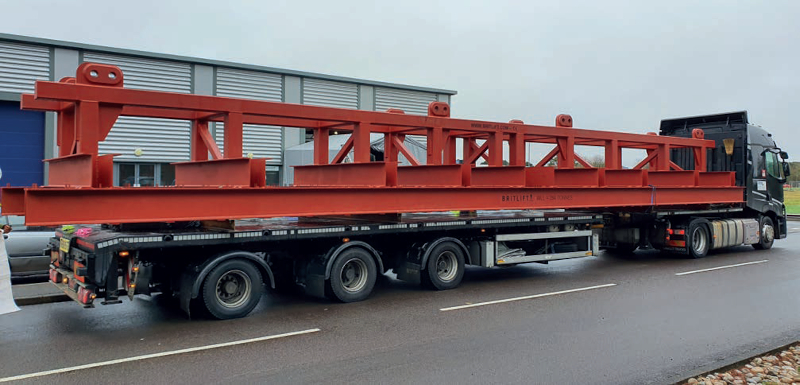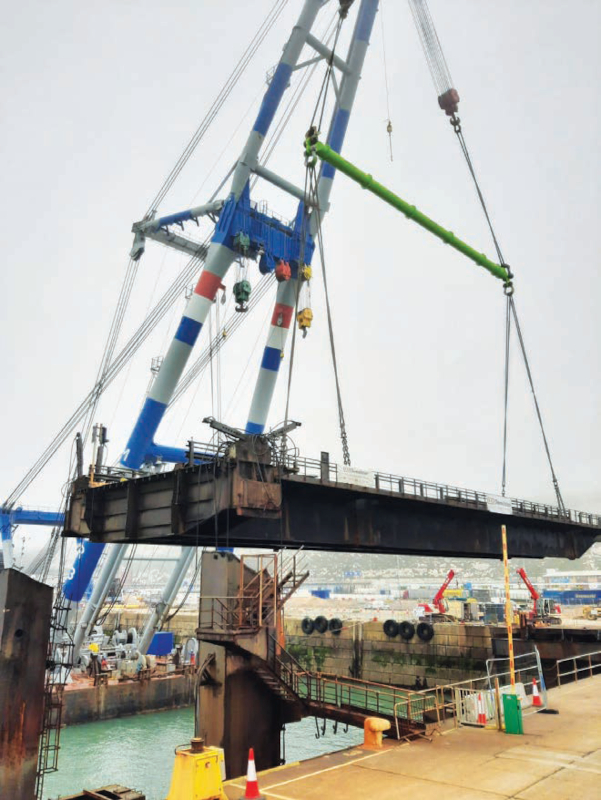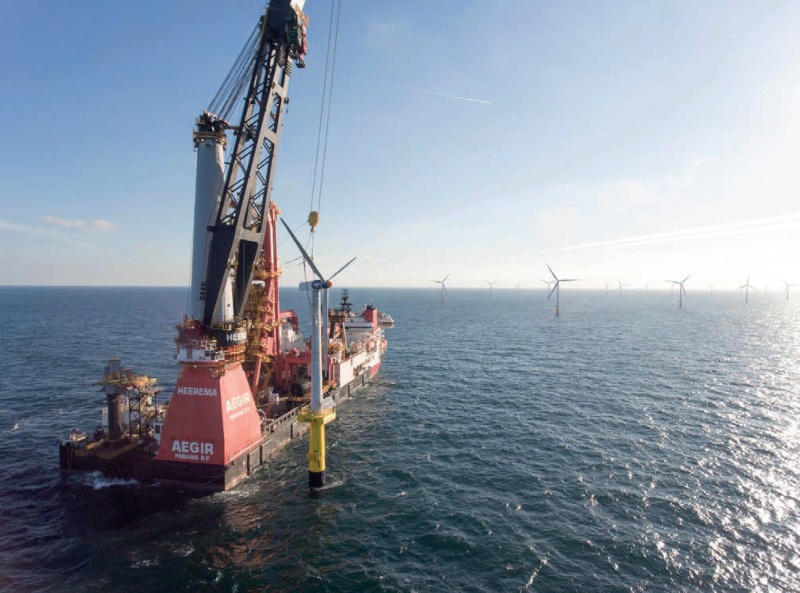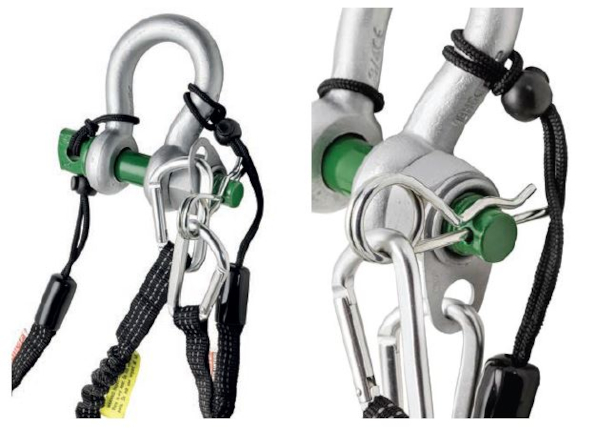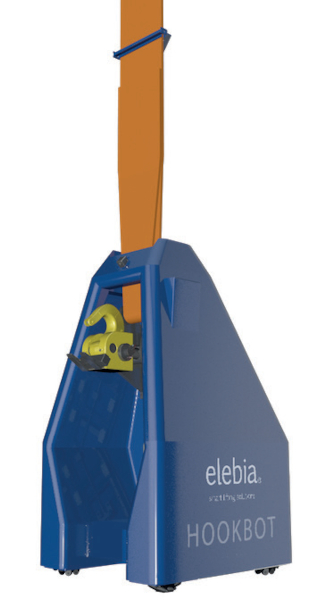Hang in there
8 June 2022Load security; ensuring that the load stays on the hook and does not fall off, is somewhat basic to all lifting operations – but none-the-less can call for ingenuity, high technology and specialised devices both large and small. Julian Champkin reports.
A windfarm was being erected in the North Sea. Huge and heavy towers were lifted into place. As is normal practice, they were supported on slings. The slings took energy to produce, and raw materials to produce them from. They were Dyneema slings, made from HMPE (High Modulus Polyethylene) fibre, which is sourced from ethylene. As a hydrocarbon, ethylene normally comes from a refinery and is cracked from fossil fuel.
“We did a CO2 audit of the emissions from the entire sling section of the installation process,” says Marc Eijssen, global technical and business development manager, marine and industrial fibre, DSM, makers of Dyneema. “Normally making the fibre for the slings, forming the usual required volume of it into slings of the right dimensions, the transport, and all the processes associated with that lift would have emitted 647 tons of CO2.”
But for the past two years, Dyneema has sourced its ethylene not from fossil fuel but renewably from bio-waste. Waste from the timber and pulp industries is collected as feedstock. (It is certified as not coming from land that might be used for growing food.) Both renewable and fossil feedstock are combined in the supplier’s processing unit to produce ethylene, but specialised mass balancing accounting ensures that the volume of ethylene used by Dyneema is more than covered by the bio-feedstock input. “Furthermore, all the electricity used in our factory is renewably-sourced – 100% of it.” The end result is claimed as the first ever bio-based ultra-high molecular weight polyethylene, and is certified by independent outside bodies.
“The bio-sourced Dyneema is identical in every way – chemically, in strength, in performance, in every other characteristic – to the fossil-sourced product,” says Eijssen. The difference comes when you do the emissions audit. “Because that North Sea windfarm used bio-based Dyneema slings, instead of 647t the carbon footprint for the operation was one-tenth of that – under 65 tons.”
Slings, rigging and below-the-hook attachments are thought of as relatively minor parts of a lift. Getting them right is, of course, one of the most essential elements as far as safety is concerned: load security must be paramount since a falling load is never good news. But Dyeema’s bio-sourced slings show that rather more than that can be involved. Such as, for example, saving the planet.
“Nor is it only the raw materials that are involved in sustainability,” says Eijssen. “It starts at the design stage – the product must not be over-engineered, not be wasting material unnecessarily but must use exactly the amount that is needed. The way the product is used – that too is important. For that we liaise with the clients, who are most definitely enthusiastic about reducing CO2. And you need an accounting mindset that considers the whole lifespan of the product: the longer it lasts the more economical it is, both in money and in the earth’s resources that will replace it. We can now use worn-out Dyneema – break it down back to the ethylene and re-constitute new fibre from that. It takes energy of course, but much less than starting from scratch; the balance comes out the right side. Chemical and mechanical recycling brings us towards the circular economy that is so vital.
Wind power is one of the success stories of renewables. Lifting the monopile towers, whether for onshore or for offshore installations, is a considerable technical challenge; lifting the turbine blades to attach them to the nacelles is if anything trickier still. They are, of necessity, made as smooth as possible, which means that there is nothing in the way of attachment points for a sling or hook.
Spanish company Airpes designs and manufactures all kinds of below-the-hook lifting attachments and has made a speciality of tools for lifting turbine blades. Its most recent is the GE-ASBI25t blade cradle; it is remote controlled, hydraulically operated, and can incline the blade up to 5 degrees in order to adjust the entrance of the blade’s root in the hub of the nacelle during installation. Using it, all three blades of a turbine can be installed in a single day.
Wind farms clearly have an expanding future; which may be why US-based Crosby Group, known like Airpes for its below-the-hook attachments for lifting almost every kind of pipe, crate, metal sheet or difficult or awkwardly-shaped load, in December last year (2021) acquired Airpes. The company now trades as Crosby Airpes.
The Green Pin brand from Van Beest are also below-the-hook specialists; and they too have an innovation that can be useful - and indeed lifesaving when erecting windfarms. Riggers at height have frequently to secure shackles to loads and to ropes or chains. Shackles generally come in three parts, the shackle itself, the pin and the nut. All three parts can be small, and it is not difficult at all to accidentally drop one. A five-centimetre nut falling from a 100-metre wind tower will be travelling at near-terminal velocity by the time it nears the ground and if it hits someone it will very likely kill them. Green Pin’s solution is simple. All the best ideas are simple once somebody else has thought of them.
Their Catch shackle BN has an attachment point, a hole or a ring, on each individual component. A lanyard can be passed through the hole, and its other end can be securely fastened to something or to someone - for example to the tool-belt that the rigger is wearing. Accidentally drop the nut, the pin or the shackle and not only is nobody hurt but you are spared the 100-metre climb down the tower to fetch a replacement nut or to fruitlessly search the grass for the old one.
The attachment point on the nut rotates, so that the nut can be screwed easily onto its cotter pin without the lanyard getting twisted. Users can use carabiner clips or similar instead of lanyards if they prefer.
The Green Pin Catch Shackle BN has been developed in cooperation with DROPS, - it stands for Dropped Objects Prevention Scheme - an industry-supported non-profit organization that is focused exclusively on preventing objects being dropped. (It is both serious and potentially life-saving.)
As well as the tethering options the shackle has a double safety design - split pin and safety bolt - which prevents accidental unscrewing of the pin. It is galvanised for long-term durability and is available in a range with a working load limit from 2 up to 9.5 ton.
Securely attaching a hook to a container can be another hazardous operation – especially if the crane or hoist is static, on a rig or platform, and the container is on a ship beneath it rolling in heavy swell. For a crewman to cross the deck, grab the heavy dangling hook, pull it, plus the weight of the crane’s wire rope, to the chains and ring that are attached to the container, and clip it on is no small task even in a flat calm. Elebia has a device that does it automatically – or to be precise, robotically. They call it the Hookbot; it is a remote-controlled robot; and it looks like a cross between a Dalek from Dr Who and one of Elebia’s more normal self-fastening hooks, the evo20, on which it is based. Unlike the evo20, though, it has four small wheels on its underside and some clever electronics inside it. It hangs from the crane hook on a sling – perhaps a bio-Dyneema one. It is lowered onto a clear part of the vessel’s deck until the sling supporting it goes slack; then it runs around the deck on its four wheels, dangling the sling, from a small mast on the robot, clear of the deck behind it. All four wheels are steerable, so it can manoeuvre itself into small gaps and turn itself to face the container it is to lift. It is remotely controlled, by radio, from the crane cab or from the vessel. Once in position the hook extends from the centre of the Hookbot, like a weapon from the belly of a Dalek, and reaches out – at a height that can be adjusted – towards the chain and lifting ring of the container, which have already been arranged to be hanging down the container’s side. When it gets close, the magnetic attraction system that is standard on Elebia’s self-attaching hooks pulls the lifting ring into the hook, which self-closes around it; and the crane operator can then lift the container from the vessel without any crew member having had to get close to swinging hooks or potentially-crushing containers. ( For a clearer view of how it works see Elebia’s video animation at www. https://elebia. com/hookbot-remote-controlled-robot-offshore- platforms/. It is fun to watch even if you yourself have no great current need to lift a container from a ship at sea.)
As Elebia point out, the relative movement between platform and ship makes transferring containers hazardous even at the best of times and often causes impacts with other containers or metal structures of the cargo ship. Close to one-third of incidents in offshore platforms are related to the lifting process.
The goal of the Hookbot’s designers is to improve safety in handling and moving containers in maritime platforms, and in extreme conditions as well as calm ones. Risk will be, if not exterminated, then at least considerably reduced.
Britlift is known for its spreader beams and lifting frames, but prides itself also on being able to engineer, design, manufacture, test and certify any type of lifting tool, attachment or bespoke lifting lug for any load whatever its weight and whatever the challenge or environment.
Recent bespoke examples include a radial bolt-on lifting tool, and heavy-duty C-hooks and scissor grabs. Rather larger than those was a recent order from Constructions Industrielles de la Méditerranée (CNIM) of France, for the full design of a lifting frame to lift a 284 ton superheater in Serbia. As part of its consultancy service, Britlift produced and issued full fabrication drawings for CNIM to subcontract the manufacture closer to the final destination of Belgrade. A strict project delivery date and high-level quality requirements were crucial to the procurement process and helped Britlift to secure the contract. After a six-week design consultancy followed by six weeks of manufacture involving 1200 manufacturing man hours the frame was delivered on time and on budget. Designed, tested and certified in-house by Britlift, detailed calculations reports, inspection and test plan, welding maps, full MPI (Magnetic Particle Inspection) and third party inspection were all supplied to the client. Britlift even built a custom testing rig. The frame was delivered early last year.
Modulift is another company specialising in spreader beams. Its latest beam is its biggest yet: the MOD 1100/2000 can lift 2000 tons. The beam was manufactured for customer Safe Lifting Europe.
Despite its size the MOD 1100/2000 spreader is in Modulift’s standard pin ended strut design, which is extremely weight and cost efficient.
Its giant span, of 33m, did however mean that Modulift had to modify its test rig: “Part of the project to supply this beast of a beam required our compressive test bed to be extended to 33 m and increased in capacity to 2,300 tons, which was quite a project in itself,” said John Baker, Modulift’s commercial director. “Its size really does make it quite an impressive thing to see.”
The beam saw its first outing in November 2021, at Dover, where it was put to work lifting parts of a bridge on behalf of Bonn & Mees Floating Cranes. The beam is modular, which meant that it could be split and transported on two trucks. For the Dover lift it travelled from Safe Lifting Europe’s yard in Rotterdam across the city to the Bonn & Mees quay. Two sheerlegs then lifted and stored it before it was shipped to Dover for the lifting operations.
For the lift itself two additional Modulift MOD 400 spreader beams were used. The assembly of the MOD 1100/2000 took the team at Safe Lifting Europe just one working day.
Safe Lifting Europe are also the first recipients of another new Modulift product. The CMOD 250 is a new corner lift for Modulift’s range of spreader frames: it can achieve a working load limit of 300 ton and reach spans of 20m x 20m. The units come with a new design that reduces the contact stresses between the top shackle bow and the corner unit centre plate. The design has two rounded contact faces, enabling the shackle bow to contact efficiently.
“Modulift always has a solution for us when we have a complicated lift,” said Jacques Vroegop, operations manager, Safe Lifting Europe, “and we were surprised with the CMOD 250. The size of span that it can reach is phenomenal; it really can form a huge frame and we can’t wait to use it later in the year.”
A second set of CMOD 250 corner units conforming to ASME cat B are being shipped to the United States shortly to facilitate a heavy lift for a shipbuilding company through Modulift’s partner, I&I Sling Co.
“One of the key selling points of the CMOD system is it’s compatibility with the standard Modulift struts,” adds Baker.
“Customers who already have Modulift struts can easily transform a beam into a frame by adding corner units. We are really looking forward to seeing both sets of CMOD 250 in action this year.”
Securely fixing a load to a hook, despite its apparent simplicity will continue to offer challenges to ingenuity.
